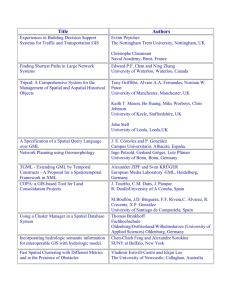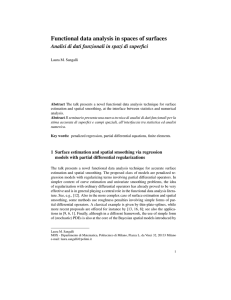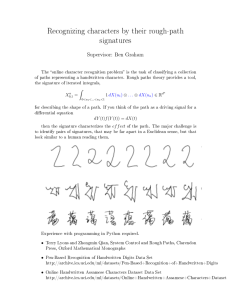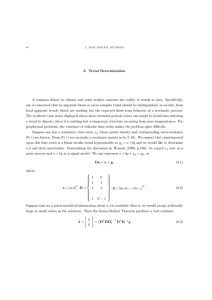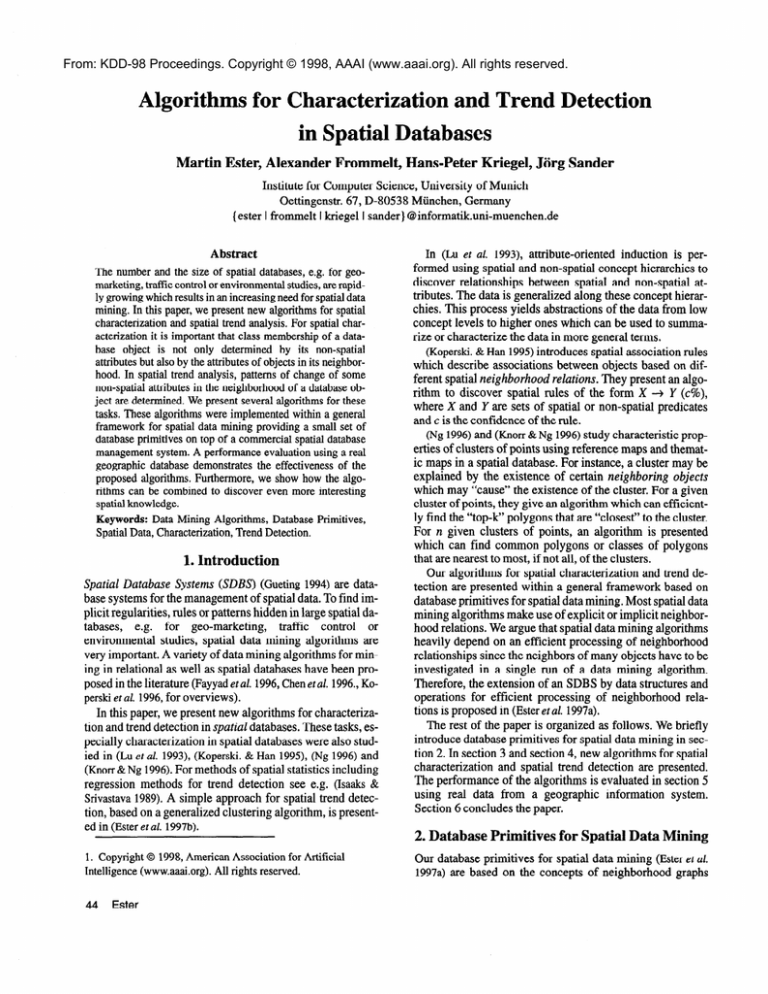
From: KDD-98 Proceedings. Copyright © 1998, AAAI (www.aaai.org). All rights reserved.
Algorithms for Characterization and Trend Detection
in Spatial Databases
Martin Ester, Alexander Frommelt, Hans-Peter Kriegel, J&g Sander
Institute for Computer Science, University of Munich
Oettingenstr. 67, D-80538 Mtinchen, Germany
{ester I frommelt I kriegel I sander} @informatik.uni-muenchen.de
Abstract
The number and the size of spatial databases,e.g. for geomarketing,traffic control or environmentalstudies,arerapidly growing which resultsin an increasingneedfor spatialdata
mining. In this paper,we presentnew algorithmsfor spatial
characterizationand spatialtrend analysis.For spatialcharacterizationit is importantthat classmembershipof a database object is not only determined by its non-spatial
attributesbut alsoby the attributesof objectsin its neighborhood. In spatial trend analysis,patternsof changeof some
non-spatialattributesin the neighborhoodof a databaseobject are determined.We presentseveralalgorithmsfor these
tasks.Thesealgorithmswere implementedwithin a general
framework for spatial data mining providing a small set of
databaseprimitives on top of a commercialspatialdatabase
managementsystem.A performanceevaluationusing a real
geographicdatabasedemonstratesthe effectivenessof the
proposedalgorithms.Furthermore,we show how the algorithms can be combinedto discover even more interesting
spatialknowledge.
Keywords: Data Mining Algorithms, DatabasePrimitives,
SpatialData, Characterization,Trend Detection.
1. Introduction
Spatial Database System (SDBS) (Gueting 1994) are database systemsfor the management of spatial data. To find implicit regularities, rules or patterns hidden in large spatial databases, e.g. for geo-marketing, traffic control or
environmental studies, spatial data mining algorithms are
very important. A variety of data mining algorithms for mining in relational as well as spatial databaseshave been proposed in the literature (Fayyadet al. 1996,Chenet al. 1996.,Koperskiet a2.1996,for overviews).
In this paper, we present new algorithms for characterization and trend detection in spatial databases.These tasks, especially characterization in spatial databaseswere also studied in (Lu et al. 1993), (Koperski.& Han 1995), (Ng 1996) and
(Knorr & Ng 1996).For methods of spatial statistics including
regression methods for trend detection see e.g. (Isaaks&
Srivastava1989). A simple approach for spatial trend detection, based on a generalized clustering algorithm, is presented in (Esteretal. 1997b).
1. Copyright 0 1998,AmericanAssociationfor Artificial
Intelligence(www.aaai.org).All rights reserved.
44
Ester
In (Lu et al. 1993), attribute-oriented induction is performed using spatial and non-spatial concept hierarchies to
discover relationships between spatial and non-spatial attributes. The data is generalized along these concept hierarchies. This process yields abstractions of the data from low
concept levels to higher ones which can be used to summarize or characterize the data in more general terms.
(Koperski.& Han 1995)introduces spatial association rules
which describe associations between objects based on different spatial neighborhood relations. They present an algorithm to discover spatial rules of the form X + Y (c%),
where X and Y are sets of spatial or non-spatial predicates
and c is the confidence of the rule.
(Ng 1996)and (Knorr & Ng 1996)study characteristic properties of clusters of points using reference maps and thematic maps in a spatial database. For instance, a cluster may be
explained by the existence of certain neighboring objects
which may “cause” the existence of the cluster. For a given
cluster of points, they give an algorithm which can efficiently find the “top-k” polygons that are “closest” to the cluster.
For n given clusters of points, an algorithm is presented
which can find common polygons or classes of polygons
that are nearest to most, if not all, of the clusters.
Our algorithms for spatial characterization and trend detection are presented within a general framework based on
databaseprimitives for spatial data mining. Most spatial data
mining algorithms make use of explicit or implicit neighborhood relations. We argue that spatial data mining algorithms
heavily depend on an efficient processing of neighborhood
relationships since the neighbors of many objects have to be
investigated in a single run of a data mining algorithm.
Therefore, the extension of an SDBS by data structures and
operations for efficient processing of neighborhood relations is proposed in (Esteret al. 1997a).
The rest of the paper is organized as follows. We briefly
introduce databaseprimitives for spatial data mining in section 2. In section 3 and section 4, new algorithms for spatial
characterization and spatial trend detection are presented.
The performance of the algorithms is evaluated in section 5
using real data from a geographic information system.
Section 6 concludes the paper.
2. Database Primitives for Spatial Data Mining
Our database primitives for spatial data mining (Esteret al.
1997a)are based on the concepts of neighborhood graphs
and neighborhood paths which in turn are defined with respect to neighborhood relations between objects.
There are three basic types of spatial relations: topological, distance and direction relations which may be combined
by logical operators to express a more complex neighborhood relation. We will only mention the direction relations
for the 2-dimensional case because they are explicitly needed for our filter predicates. To define the direction relations,
e.g. 02 south 01, we consider one representative point of the
object OI as the origin of a virtual coordinate system whose
quadrants and half-planes define the directions. To fulfil the
direction predicate, all points of 02 have to be located in the
respective area of the plane. Figure 1 illustrates the definition of some direction relations using 2D polygons.
Obviously, the directions are not uniquely defined but
there is always a smallest direction relation for two objects A
and B, called the exact direction relation of A and B, which is
uniquely determined. For instance, in figure 1 A and B satisfy the direction relations northeast and east but the exact direction relation of A and B is northeast.
E any-direction A
B north A
,A
B east A,
C east A
D south A
figure 1: Illustration
of some direction relations
Definition 1: (neighborhood graphs and paths) Let neighbor be a neighborhood relation and DB be a databaseof spatial objects. A neighborhood graph
Gfighbor = (N, E)
is a graph with nodes N = DB and edges E c N x N where
an edge e = (nl, n2) exists iff neighbor(nl,n$ holds. A
neighborhood path of length k is defined as a sequence of
nodes [nl, n2, . . ., qJ, where neighbor(ni, ni+l) holds for all
niE N, 1 lick
.
We assume the standard operations from relational algebra like selection, union, intersection and difference to be
available for sets of objects and sets of neighborhood paths
(e.g., the operation seZection(set,predicate) returns the set of
all elements of a set satisfying the predicate predicate).
Only the following important operations are briefly described:
neighbors: Graphs x Objects x Predicates -->
Sets-of-objects
paths: Sets-of-objects --> Sets-of-paths;
extensions: Graphs x Sets-of-paths x Integer x Predicates -> Sets-of-paths
The operation neighbors(graph, object, predicate) returns
the set of all objects connected to object in graph satisfying
the conditions expressed by the predicate predicate.
The operation paths(objects) creates all paths of length 1
formed by a single element of objects and the operation extensions(graph, paths, max, predicate) returns the set of all
paths extending one of the elements of paths by at most max
nodes of graph. The extended paths must satisfy the predicate predicate. The elements of paths are not contained in
the result implying that an empty result indicates that none
of the elements of paths could be extended.
Because the number of neighborhood paths may become
very large, the argument predicate in the operations neighbors and extensions acts as a filter to restrict the number of
neighbors and paths to certain types of neighbors or paths.
The definition of predicate may use spatial as well as nonspatial attributes of the objects or paths.
For the purpose of KDD, we are mostly interested in paths
“leading away” from the start object. We conjecture that a
spatial KDD algorithm using a set of paths which are crossing the space in arbitrary ways will not produce useful patterns. The reason is that spatial patterns are most often the
effect of some kind of influence of an object on other objects
in its neighborhood. Furthermore, this influence typically
decreases or increases more or less continuously with increasing or decreasing distance. To create only relevant
paths, we introduce special filter predicates which select
only a subset of all paths, thus also significantly reducing the
runtime of data mining algorithms.
There are many possibilities to define “starlike” filters.
The filter starlike, e.g., requires that, when extending a path
p = [q,n2,..., nk] with a node nk+I, the exact “final” direction
of p may not be generalized. For instance, a path with final direction northeast can only be extended by a node of an edge
with the exact direction northeast. The filter variable-starlike
requires only that, when extending p the edge (nk, nk+l) has
to fulfil at least the exact “initial” direction of p. For instance,a neighborhood path with initial direction north can be
extended such that the direction north or the more special direction northeast is satisfied. Figure 2 illustrates these filters
when extending the paths from a given start object. The figure also depicts another filter vertical starlike which is less
restrictive in vertical than in horizontal direction.
starlike
figure 2: Illustration
vertical~turlike
of some filter predicates
l
3. Spatial Characterization
l
l
We define a spatial characterization of a given set of target
objects with respect to the database containing these targets
as a description of the spatial and non-spatial properties
which are typical for the target objects but not for the whole
database. We use the relative frequencies of the non-spatial
KDD-98
45
attribute values and the relative frequencies of the different
object types as the interesting properties. For instance, dif-
attributes
attributes
(a) relative frequencies
in the database
(b) relative frequencies
in the target regions
g
4
t?
Q
E
b
-
significance
(c) ratio of the frequencies
figure 3: Sample frequencies and differences
ferent object types in a geographic database are communities, mountains, lakes, highways, railroads etc. To obtain a
spatial characterization, we consider not only the properties
of the target objects, but also the properties of their neighbors up to a given maximum number of edges in the neighborhood graph. Figure 3 depicts an example for the relative
frequencies in the database as well as in the target regions
and the ratio of these frequencies in comparison with the
specified level of significance.
The task of spatial characterization is to discover the set of
all tuples (attribute, value) and the set of all objects types for
which the relative frequency in a set targets, extended by its
characterization(graph
Gf
neighbors, is significantly different from the relative frequency in DB. A very frequent property present only in the
neighborhood of very few of the targets would create misleading results. Therefore, we require that such a property
must also have a significantly larger relative frequency in
the neighborhood of many targets.
Definition 2: (spatial characterization): Let Gfzghbor be
a neighborhood graph and targets be a subset of DB. Let
freqS(prop) denote the number of occurrences of the property prop in the set s and let card(s) denote the cardinality of s.
Thefrequency factor of prop with respect to targets and DB,
denoted by fFzg,,,(prop), is defined as follows:
fargets(prop) freqDB(prop)
f F$ets(ProP) = ‘raTd(targets)
’ card( DB)
Let significance and proportion be real numbers and let
ma-neighbors be a natural number. Let neighbor+(s)
denote the set of all objects reachable from one of the elements of s by traversing at most i of the edges of the neighborhood graph G. Then, the task of spatial characterization
is to discover each property prop and each natural number
n I max-neighbors such that (1) the set objects =
as well as (2) the sets objects =
neighborsa(targets)
neighborsE({ t}) for at least proportion many t E targets
satisfy the condition:
f ftects(ProP)
2 significance
Or
1
5
significance
In point (1) the union of the neighborhood of all target objects is considered simultaneously, whereas in point (2) the
; set of objects targets; real signifiance, proportion; integer mux-neighbors:
initialize the set of characterizations as empty;
initialize the set of regions to targets;
initialize n to 0;
calculate frequencPB@rop) for all properties prop = (attribute, value);
while n I max-neighbors do
for each attribute of DB and for the special attribute object type do
for each value of attribute do
calculatefrequencyregions(prop) for property prop = (attribute, value);
if f f)eBgions(ProP)2 significance or f f)eBions(prop) I 11 significance then
add (Prop, It, f gfions(prop) ) to the set characterizations;
if n < max-neighbors then
for each object in regions do
add neighbors( GrB , object, TRUE) to regions;
increment n by 1;
extract all tuples (prop, n, f(prop)) from characterizations which are significant in at least proportion of the
regions with n extensions;
return the rule generated from these characterizations;
figure 4: Algorithm spatial characterization
46
Ester
neighborhood of each target object is considered separately.
The parameter proportion specifies the minimum confidence required for the characterization rules and the frequency factors of the properties provide a measure of their
interestingness with respect to the given target objects.
Figure 4 presents the algorithm for discovering spatial
characterizations. The parameter proportion is relevant only
for the last step of the algorithm, i.e. for the generation of a
rule. Note the importance of the parameter n (that is, the
maximum number of edges of the neighborhood graph traversed starting from a target object) in the resulting characterizations. For example, a property may be significant when
considering all neighbors which are reachable from one of
the target objects via 2 edges of the neighborhood graph.
However, the same property may not be significant when
considering further neighbors if then the target regions are
extended by objects for which the property is not frequent.
The generated rule has the following format:
target * pl (nl, freq-facl) fi . .. A pk (nk, freq- fack).
This rule means that for the set of all targets extended by
ni neighbors, the property pi isfreq-faci times more (or less)
frequent than in the database.
4. Spatial Trend Detection
We define a spatial trend as a regular change of one or more
non-spatial attributes when moving away from a given start
object o. We use neighborhood paths starting from o to model the movement and we perform a regression analysis on the
respective attribute values for the objects of a neighborhood
path to describe the regularity of change. Since we are interested in trends with respect to o, we use the distance from o
as the independent variable and the difference of the at-
tribute values as the dependent variable(s) for the regression.
The correlation of the observed attribute values with the values predicted by the regression function yields a measure of
confidence for the discovered trend.
(a) positive trend
(b) negative trend
(c) no trend
figure 5: Sample trends
In the following, we will use linear regression, since it is
efficient and often the influence of some phenomenon to its
neighborhood is either linear or may be transformed into a
linear model, e.g. exponential regression. Figure 5 illustrates a positive and a negative (linear) trend as well as a situation where no significant (linear) trend is observed.
Definition 3: (spatial trend detection): Let g be a neighborhood graph, o an object (node) in g. and a be a subset of all
non-spatial attributes. Let # be a type of function, e.g. linear
or exponential, used for the regression and letfilter be one of
the filters for neighborhood paths. Let min-conf be a real
number and let min-length as well as mu-length be natural
numbers. The task of spatial trend detection is to discover
the set of all neighborhood paths in g starting from o and
having a trend of type # in attributes a with a correlation of at
least min-conf. The paths have to satisfy the filter and their
length must be between min-length and max-length.
global-trend(graph g; object o; attribute a; type t; real min-conf, integer min-Zength,max-length; filtern
initialize a list of paths to the set extensions(g, path(o), min-length, f3;
initialize an empty set of observations;
initialize the last-correlation and last-paths as empty;
initialize first-pos to 1;
initialize last-pos to min-length;
while paths is not empty do
for each path in paths do
for object fromfirst-pos of path to last-pos of path do
calculate diffas a(objec#) - a(o) and calculate dist as dis#(objec#,o);
insert the tuple (difl, dist) into the set of observations;
perform a regression of type t on the set of observations;
if abs(correlation) of the resulting regression function 2 min-conf then
set last-correlation to correlation and last-paths to paths;
if the length of the paths < max-length then
replace the paths by the set extensions(g,paths,1, fi;
increment last-pos by 1;
set first-pos to last-pos;
else set paths to the empty list;
else return last-correlation and last-paths;
return the last correlation and last-paths;
figure 6: Algorithm global-trend
KDD-98
47
local-trends(graph g; object o; attribute a; type t; real min-conf, integer min-Zengthpzux-Zength; filters)
initialize a list of paths to the set extensions(g, path(o), min-length, fl;
initialize two empty sets of positive and negative trends;
while paths is not empty do
initialize the set of observations as empty;
remove the first element of paths and take it as path;
for object from min-length& object of path to last object of path do
calculate di$fas a(object) - a(o) and calculate dist as dist(object,o);
insert the tuple (di#,dist) into the set of observations;
perform a regression of type t on the set of observations;
I
if abs(correlation) of the resulting regression function 2 min-conf then
if correlation > 0 then
insert the tuple (path, correlation) into the set of positive trends;
else insert the tuple (path, correlation) into the set of negative trends;
if the length of path c max-length then
add the extensions(g,path,I, f) to the head of paths;
return positive-trends and negative-trends;
figure 7: Algorithm local-trends
Definition 3 allows different specializations. Either the
set of all discovered neighborhood paths (global trend) or
each of its elements (local trend) must have a trend of the
specified type.
Algorithm global-trend is depicted in figure 6. Beginning
from o, it creates all neighborhood paths of the same length
simultaneously - starting with min-length and continuing
until max-length. The regression is performed once for each
of these sets of all paths of the same length. If no trend of
length I with correlation 2 min-conf is detected, then the path
extensions of length Z+I, Z+Z, . . ., max-length are not created. The algorithm returns the significant spatial trend with
the maximum length.
Algorithm local-trends is outlined in figure 7. This algorithm performs a regression once for each of the neighborhood paths with length 1 min-length and a path is only extended further if it has a significant trend. The algorithm
returns two sets of paths showing a significant spatial trend,
a set of positive trends and a set of negative trends.
Relation Bavarian Communities:
5. Performance Evaluation
We implemented the database primitives on top of the commercial DBMS Illustra (Illustra 1997) using its 2D spatial
data blade which offers R-trees. The advantage of this approach is an easy and rather portable implementation. The
disadvantage is that we cannot reduce the relatively large
system overhead imposed by the underlying DBMS.
A geographic databaseon Bavaria was used for the experimental performance evaluation of our algorithms. The database contains the ATKIS 500 data (Bavarian StateBureauof
Topographyand Geodesy1996) and the Bavarian part of the
statistical data obtained by the German census of 1987, i.e.
2043 Bavarian communities with one spatial attribute (polygon) and 52 non-spatial attributes (such as average rent or
rate of unemployment). Also included are spatial objects
representing natural object like mountains or rivers and in48
Ester
figure 8: Spatial and non-spatial attributes
frastructure such as highways or railroads. The total number
of spatial objects in the databasethen amounts to 6924. The
relation communities is sketched in figure 8. This geographic database may be used, e.g., by economic geographers to
discover spatial rules on the economic power of communities. We performed several sets of experiments to measure
the performance of our characterization and spatial trend detection algorithms. Note, that the runtime of the algorithms
is in general not dependent on the database size but on the
size of the input and on the number of neighborhood operations performed for the considered objects. This number depends on the average number of neighbors per object in the
database which is an application dependent parameter. In
our geographic information system the average number of
neighboring communities is approximately six.
5.1 Characterization
The characterization algorithm usually starts with a small set
of target objects, selected for instance by a condition on
some non-spatial attribute(s) such as “rate of retired people
= HIGH” (see figure 9, left). Then, the algorithms expands
regions around the target objects, simultaneously selecting
those attributes of the regions for which the distribution of
values differs significantly from the distribution in the whole
database (figure 9, right). In the last step of the algorithm, a
characterization rule is generated describing the target regions (figure 9, bottom). In this example, not only some
non-spatial attributes but also the neighborhood of mountains (after three extensions) are significant for the characterization of the target regions.
target objects
maximally expanded regions
rule characterizing the target objects
object has high rate of retired people 3
apartments per building = very low (0,g.l) A
rate of foreigners = very low (0,8.9) A
rate of academics = medium (0, 6.3) A
average size of enterprises = very low (0,5.8)
object type = mountain (3,4.1)
5.2 Trend Detection
Spatial trends describe a regular change of non-spatial attributes when moving away from a start object o. The two algorithms above may produce different patterns of change for
the same start object o.
The existence of a global trend for a start object o indicates that if considering all objects on all paths starting from
o the values for the specified attribute(s) in general tend to
increase (decrease)with increasing distance. Figure 10 (left)
depicts the result of algorithm global-trend for the attribute
“average rent” and the city of Regensburg as a start object.
Algorithm local-trends detects single paths starting from
an object o and having a certain trend. The paths starting
from o may show different pattern of change, e.g., some
trends may be positive while the others may be negative.
Figure 10 (right) illustrates this case for the attribute “average rent” and the city of Regensburg as a start object.
The spatial objects within a trend region, i.e. either the
start objects or the objects forming the paths, may be the
subject of further analysis. For instance, algorithm globaltrend may detect regions showing a certain global trend, and
algorithm local-trends then finds within these regions some
paths having the inverse trend (see figure 10). Then, we may
try to find an explanation for those “inverse” paths. Another
possibility is to detect “centers” for a given attribute first
(using algorithm global-trend) and then apply our characterization algorithm to the centers to find their common properties. An example for this approach is presented in more detail in section 5.3.
A
figure 9: Characterizing wrt. high rate of retired people
Table 1 reports the efficiency of our spatial characterization algorithm. The numbers are calculated as the average
over all start objects for several experiments with different
target sets.
Global trend (min-conk0.7)
+
Local trends (tin-confi0.9)
direction of decreasing attribute values
figure 10: Visualization of trends for attribute “average
rent” starting from the city of Regensburg
For our performance test we applied both algorithms to
the Bavaria databasevarying min-con.dence from 0.6 to 0.8
for the attribute “average rent” and linear type of regression.
The predicate intersects was used as the neighborhood relation to define the graph. The filter vertical starlike for paths
was used because due to our domain knowledge we expected the most significant trends in north-south direction. The
length of the paths was restricted by min-length = 4 and maxlength = 7.
Table 2 reports the performance results for the algorithms
global-trend and local-trends. The average numbers shown
were calculated over all start objects.
Table 1: Performance of spatial characterization
KDD-98
49
correlation
0 neighbors
operations
0 runtime (sec.)
to discover not only summarizing characterization miesbut
also discriminating rules. Furthermore, neighborhood paths
may also be used as input for the well-known relational data
mining algorithms such as decision tree classifiers. Alternatively, new spatial data mining algorithms operating directly
on neighborhood graphs and paths will be investigated.
Acknowledgments
We thank Stefan Gundlach for fruitful discussions and his
implementation of the database primitives for spatial data
mining.
1 correlation 11
( 0 runtime (sec.)
Table 2: Performance of both trend algorithm
5.3 Combining Trend Detection and
Characterization
In our last set of experiments, we combined trend detection
and characterization. In a first step, we detected centers for
attribute “average rent” using algorithm global-trend: minimum correlation was set to 0.7 and we selected only those
communities where the slope of the trend was less than - 1OS4
and the path length was not smaller than 5, i.e. we were only
interested in linear trends that are noticeably decreasing.
With this definition, we found 24 centers out of the 2043
communities. The characterization rule discovered for these
centers contains the following properties:
rate of academics = high (1,9. l),
average number of persons per household = low (1,2.5),
rate of foreigners = low (1,2.8).
Note that no attribute was significant for n = 0, i.e. without
considering the neighborhood of the target object. Only if
we extend the target regions by one neighbor, we can see
some characteristic properties. Thus, this result could not be
found by a non-spatial characterization algorithm.
6. Conclusions
In this paper, we presented new algorithms for spatial characterization and spatial trend detection. To obtain a spatial
characterization, we consider not only the properties of the
target objects but also the properties of their neighbors. The
goal of spatial trend analysis is to discover patterns of
change of some non-spatial attribute(s) in the neighborhood
of a start object. The algorithms were implemented within a
general framework for spatial data mining providing a small
set of databaseprimitives on top of a commercial spatial database management system. The effectiveness of the proposed algorithms was demonstrated by a performance evaluation using a real geographic database.
Future research will have to consider the following issues.
The algorithm for spatial characterization might be extended
50
Ester
References
Chen M.-S., Han J., Yu P.S. 1996. Data Mining: An
Overview from a Database Perspective. ZEEE Transactions
on Knowledge and Data Engineering, 8(6): 866-883.
Ester M., Kriegel H.-P. & Sander J. 1997a. Spatial Data
Mining: A Database Approach. Proc. 5th Znt. Symp. on Large
Spatial Databases, 47-66, Berlin: Springer.
Ester M., Kriegel H-P, Sander J. & Xu X. 1997b. DensityConnected Sets and their Application for Trend Detection in
Spatial Databases. Proc. 3rd Znt. Conf on Knowledge
Discovery and Data Mining, 10-15, Menlo Park, CA: AAAI
Press.
Fayyad U., Piatetsky-Shapiro G. & Smyth P. 1996.
Knowledge Discovery and Data Mining: Towards a
Unifying Framework Proc. 2nd Znt. Conjc:on Knowledge
Discovery and Data Mining, 82-88, Menlo Park, CA: AAAI
Press.
Gueting, R.H. 1994. An Introduction to Spatial Database
Systems. VLDB Journal 3(4).
Illustra Information Technologies, Inc. 1997. Illustra User’s
Guide. Release 3.3.1 for HP UX 10.1.
Isaaks E.H. & Srivastava R.M. 1989. Applied Geostatistics.
New York: Oxford University Press.
Koperski K. & Han J. 1995. Discovery of Spatial Association
Rules in Geographic Information Databases. Proc. 4th Znt.
Symp. on Large Spatial Databases, 47-66. Berlin: Springer.
Koperski K., Adhikary J., Han J. 1996. Knowledge
Discovery in Spatial Databases: Progress and Challenges.
Proc. SIGMOD Workshop on Research Issues in Data
Mining and Knowledge Discovery, Technical Report 96-08,
University of British Columbia, Vancouver, Canada.
Knorr E.M. & Ng R.T. 1996. Finding Aggregate Proximity
Relationships and Commonalities in Spatial Data Mining.
IEEE Transactions on Knowledge and Data Engineering,
8(6):884-897.
Lu W., Han J., Ooi B.C. 1993. Discovery of General
Knowledge in Large Spatial Databases. Proc. Far East
Workshop on Geographic Information Systems, Singapore,
275-289.
Ng, R.T. 1996. Spatial Data Mining: Discovering
Knowledge of Clusters from Maps. Proc. SIGMOD
Workshop on Research Issues in Data Mining and
Knowledge Discovery, Technical Report 96-08, University
of British Columbia, Vancouver, Canada.

